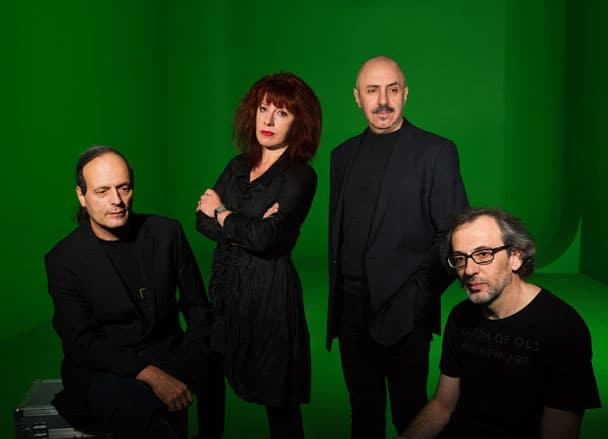Moscow-based AES+F Collective’s body of work is reflective of the nuanced backgrounds of collective members Tatiana Arzamasova, Lev Evzovich, Evgeny Svyatsky and Vladimir Fridkes — the first letters of their last names creating the group’s moniker. Husband and wife Evzovich (b. 1958) and Arzamasova (b. 1955) trained as “conceptual architects” at the Moscow Architectural Institute. Svyatsky (b. 1957) is a graphic artist who studied at Moscow University of Printing Arts, and Fridkes (b. 1956) is best known for his fashion photography; his work has appeared in publications like Vogue, Elle, and Harper’s Bazaar. Formerly known just as AES, the group became AES+F when Fridkes joined in 1995. Each artist’s skill set and creative thumbprint can be found in the works of the collective, which has been collaborating since 1987, when Russia was still the USSR.
Comprised of artists from seemingly unrelated artistic niches, the collective’s efforts have spanned across an array of artistic platforms — including sculpture, video installation, computer-based art, photography, drawings, performance — and media, from polymer paint, fiberglass, porcelain, steel, wood and more. Their work has appeared in museums and collections in Russia, the U.S., Germany, Switzerland, France, Spain and South Korea.
Varied as the minds behind them, the works of the collective have addressed many different themes. The group’s works comment on consumerism, popular culture and mass media, fashion, advertising, religion and luxury. A number of their works are also interactive and rely on audience engagement to make their statement.
One such work is the 1997 photo series “Suspects: Seven Sinners and Seven Righteous,” which juxtaposed seven images of ordinary Moscow teen girls aged 11 to 14 with seven other seemingly innocuous Moscow teen girls who happened to be convicted murderers. The catch? AES+F doesn’t label the large-scale photographs — leaving the audience to discern who among the fourteen girls are criminals.
According to the artist statement, those that are criminal committed “common sense murders,” including one in which a girl killed a man for making unwanted sexual advances. “The spectator is frustrated by the question, ‘Who is the murderer?’ He involuntarily acts in a role of the witness, called to find out noticeable signs. On the opening of the exhibition, a performance would be held starring a 10-12 year old girl wearing a red dress, gloves and shoes, who distributes lottery tickets among the public. The visitor who guessed the seven murders gets a prize,” the statement reads. In a review of the exhibition at the Station Museum of Contemporary Art in Houston, Texas, a Houston Press critic wrote, “Ultimately, anybody could be anything, the series seems to say.”
In 2003, the group began their series “Action Half Life,” which in part was a multimedia work and video installation. A commentary on real and imagined violence, from actual warfare to video game battles, three screens projected images of young children in battle scenes, dressed in camouflage and bearing weapons. “What’s the difference between physically and mentally engaging in violence?” a Houston Press critic wrote of the exhibition at the Station Museum of Contemporary Art.
The group’s “Islamic Project,” an ongoing series spanning from 1996 to 2003, asks audiences to examine their conceptions about Islam, especially in a post 9/11 world. Mixing installation art and performance, AES+F presents a fictitious, surrealist travel agency to “the Future,” where Western and Islamic culture are more interweaved than ever before. According to the artist statement, audiences can purchase souvenirs from the fake travel agency. Graphic art lends a hand to making the AES Travel Agency seem real, complete with posters, postcards, mugs and T-Shirts bearing the mock logo. That future is depicted in computer-manipulated photos that showcase a surreal new world order.
One image, “New Liberty,” shows the Statue of Liberty’s face obstructed by a hijab and bearing the Koran. The architectural training of Arzamasova and Evzovich seem to play a role in this series, as many of the images depict notable locations across the globe and re-imagine them in a world that plays out fears of an Islamic take-over. According to the artist statement, the Islamic Project series “works as a kind of psychoanalysis — visualization of fears in Western society about Islam.” Many of the works seem to mock these fears, hyper-sensationalized by mass media coverage and the prevalence of misinformation.
Fridkes’ fashion photography comes into play in the 2000-2007 series “Defile.” Here, the group juxtaposes the temporary, fleeting, and only selectively accessible world of high fashion with the inevitable and ugly reality of death, which is remains unavoidable for every class. Using corpse “models” from a Moscow morgue, the collective photographed the dead bodies and digitally dressed them in bizarre fashions. “An obsession with fashion, symbolizing temporality, can be seen as a way to deal with the fear of death. It is an ancient preoccupation, as can be seen in the elaborate rituals in Western and non-Western cultures associated with death. Humans have always attempted to ‘decorate’ death, based in part with a desire to ward it off.”
It continues, “We were motivated by the idea of pairing fashion, with its extreme temporality, with death — with its constancy and inevitability.” For the project, the group placed the seven corpses on individual light boxes, making it look as though the corpses are suspended in air or even standing upright themselves, dressed in their fashions while each appearing to be in various states of decay and rigor mortis.
The group still continues to create art, living and working in Moscow. Artist statements, photo and video of their pieces can be found at their official web site at www.aesf-group.org
REFERENCES
http://www.aesf-group.org/
http://www.bos17.com
http://artinfo.ru
http://www.wallpaper.com
http://www.houstonpress.com
http://www.houstonpress.com (2)
http://www.sothebys.com
http://www.seditionart.com
http://artinvestment.ru







